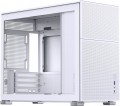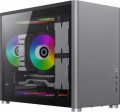Graphics card max lenght
The maximum length of a graphics card that can be installed in this case.
Modern mid-range and top-end video cards with high performance often differ in considerable length, which is why such a card can not fit into any case. So before collecting components, it is worth evaluating the length of the proposed graphics card and choosing a case in which it is guaranteed to fit. This forethought is useful anyway, but it's especially true if you're building a system that requires a powerful graphics adapter, such as a high-end gaming PC or 3D design workstation.
internal 2.5" compartments
The number
of internal 2.5" bays provided in the case design.
Such bays are mainly used for installing internal hard drives and SSD modules; The 2.5" form factor was originally created as "laptop" form factor, but recently it has been increasingly used in components for full-size PCs. At the same time, when evaluating the number of these bays, note that drives are recommended to be installed through a slot; so in Ideally, the number of bays should be twice the planned number of drives.
Also note that some cases use combined bays: initially they have a size of 3.5", but if desired, they can be converted to 2.5". These bays count towards both 3.5-inch and 2.5-inch slots. In fact, this means that the total number of available slots is not always equal to the sum of the number of both. For example, a case with 10 3.5" bays and 6 2.5" bays can have 4 combined bays, and the total number of slots in this case will not be 16, but only 12.
Fans (front)
The number of fan slots
on the front of the case, and the size of the fans these slots are designed for. The presence of the fans themselves in the kit should be specified separately.
The larger the fan, the more advanced it is considered: a large diameter allows you to work efficiently at relatively low speeds, which reduces the noise level and energy consumption. Case fans are available in several standard diameters; specifically for the front panel, the size
up to 92 mm is considered relatively small,
120 mm — medium,
140 mm — large, and in the most advanced solutions, fans of
180 mm or even more can be installed.
Also note that most often the holes for installing fans are designed for one specific size, however, there are also “multi-size” seats, for 2-3 options. Moreover, these options may differ both in diameter and in quantity: for example, it may be possible to install two 140 mm fans or three 120 mm fans.
Fan mounts total
The total number of places for installing fans provided in the chassis design.
The more performant the system, the more components it includes — the more powerful cooling it will need; therefore, the number of places for fans, usually, is directly related to the size and purpose of the case. It is also worth considering that with the same number, the installation location of individual fans may be different — behind, on the side, on top, etc.
Dust filter
The presence of a special filter in the housing to prevent dust from entering. Without such a filter, dust settles on the system elements; Radiators are especially susceptible to this; they also lose their efficiency by becoming clogged with dust. If you have
a dust filter, you have to clean not the “filling” of the PC, but the filter element itself, which is much simpler and more convenient.
Compartments for dust filters can be located on
the front panel of the case,
back,
bottom,
top, or
in the side walls. There are also case models with several technological niches for installing dust filters - the combined version assumes the presence of such compartments on several sides of the case at once.
Liquid cooling (rear)
The size of the seat for the water cooling system provided on the back of the case.
In cases with CBO support, water cooling radiators are installed in the same slots as traditional fans. In other words, either a fan (fans) or a CBO radiator can be installed on the same seat. The size of the seat under the CBO is indicated by one number — the length (on the larger side); the width can be determined based on these data. The fact is that modern CBO radiators usually use fans of one of the standard sizes — 120 mm or 140 mm; and if there are several such fans, they are arranged in a row. As a result, the length of the radiator turns out to be a multiple, and the width is equal to one of these numbers: for example, 280 mm is 2x140 mm with a width of 140 mm, and 360 mm is 3x120 mm with a width of 120 mm.
Note that in this case, the same nuances are relevant as for air cooling: a larger fan takes up more space and costs more, but it is considered more advanced, as it can work efficiently at a lower speed — and this reduces the level of noise and vibration.
Liquid cooling (top)
The size of the seat for the water cooling system provided on the top side of the case.
In cases with CBO support, water cooling radiators are installed in the same slots as traditional fans. In other words, either a fan (fans) or a CBO radiator can be installed on the same seat. The size of the seat under the CBO is indicated by one number — the length (on the larger side); the width can be determined based on these data. The fact is that modern CBO radiators usually use fans of one of the standard sizes — 120 mm or 140 mm; and if there are several such fans, they are arranged in a row. As a result, the length of the radiator turns out to be a multiple, and the width is equal to one of these numbers: for example,
280 mm is 2x140 mm with a width of 140 mm, and 360 mm is 3x120 mm with a width of 120 mm. In general, the size of the upper radiator of
240 mm or less is considered relatively small, 280 mm — medium,
360 mm — large, and in some models it reaches
420 mm or even more.
Note that in this case, the same nuances are relevant as for air cooling: a larger fan takes up more space and costs more, but it is considered more advanced, as it can work efficiently at a lower speed — and this reduces the level of noise and vibration.
Liquid cooling (bottom)
The size of the seat for the water cooling system provided on the underside of the case.
In cases with CBO support, water cooling radiators are installed in the same slots as traditional fans. In other words, either a fan (fans) or a CBO radiator can be installed on the same seat. The size of the seat under the CBO is indicated by one number — the length (on the larger side); the width can be determined based on these data. The fact is that modern CBO radiators usually use fans of one of the standard sizes — 120 mm or 140 mm; and if there are several such fans, they are arranged in a row. As a result, the length of the radiator turns out to be a multiple, and the width is equal to one of these numbers: for example, 280 mm is 2x140 mm with a width of 140 mm, and 360 mm is 3x120 mm with a width of 120 mm.
Note that in this case, the same nuances are relevant as for air cooling: a larger fan takes up more space and costs more, but it is considered more advanced, as it can work efficiently at a lower speed — and this reduces the level of noise and vibration.
Liquid cooling mounts
The total number of places for water cooling systems provided in the case, in other words, the largest number of CBO radiators that can be installed in the case. Such radiators are usually placed one at a time on the side of the case, so several radiators are most often located on different sides: for example, 3 places for CBO can be located at the back, top and front.
When estimating the number of seats (of all types), it should be taken into account that CBO fans and radiators usually use the same seats.

